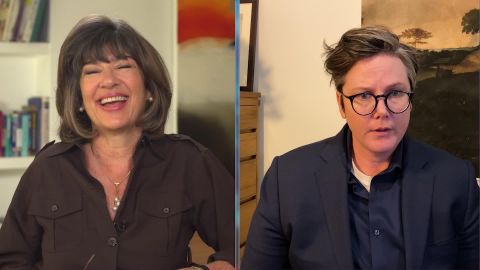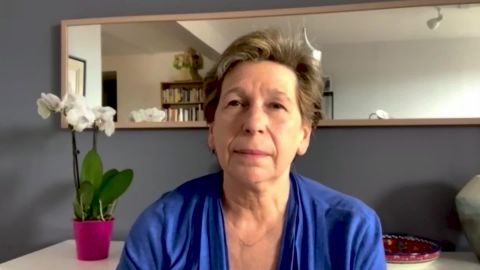Read Transcript EXPAND
CHRISTIANE AMANPOUR: With COVID surging again, major school districts like Los Angeles and San Diego say they will stay closed in the fall, despite pressure from the White House to reopen, with President Trump even threatening to cut funding. Our next guest is Randi Weingarten. She is president of the union the American Federation of Teachers. And here’s our Hari Sreenivasan talking to her about this polarizing dilemma which affects teachers, parents, and, of course, the children.
HARI SREENIVASAN: Thank you, Christiane. Randi Weingarten, thanks so much for joining us. You represent 1.7 million teachers out there. What are they telling you right now?
RANDI WEINGARTEN, PRESIDENT, AMERICAN FEDERATION OF TEACHERS: Well, we represent teachers. We’re the second largest nurse union. And what they’re saying is, they’re pretty anxious at this moment, particularly given the surge in cases in the South and the Southwest, and the — I would say the recklessness and dangerousness of Trump and DeVos last week. And they’re stamping their feet, and saying — and trying to pit safety vs. education. Before that, and let me — you know, I don’t normally do props, Hari, but, in April we put out this plan that said how you open schools safely, because we wanted to make sure that schools open better than they closed, in that kind of haphazard, closing within three to four days, everybody on remote learning. And so we really spent the time in March and April studying everything we could study to figure out how to marry the public health tools with the instructional and well-being strategies we knew that kids would need in the aftermath of having schools closed that quickly in the middle of a pandemic and now in the middle of a recession, and now in the middle of a racial justice crisis. So, before Trump and DeVos’ antics last week, we had done a poll in late June. And 76 percent of my members said that, if we got the safeguards that the AFT had been promoting since April, they were comfortable going back to in-person learning, 76 percent. But since that point, what you’re starting to see is an unraveling, because no one trusted DeVos beforehand, but now you see both parents and teachers saying, don’t pit our safety and our children’s safety against their education. We need both.
SREENIVASAN: Recently, there was a “New York Times” analysis that found only two of the largest 10 school districts in the country are ready to go back into anything close to normal because their infection rates are getting lower. I’m in Florida, where — that has five of the top 10 largest school districts, and there are lots of school districts here that are at this point, in mid-July, when we are having this conversation, trying to plan on getting kids back into classrooms. How do you do that when the infection rates aren’t even on the downslope yet?
WEINGARTEN: So, I thought “The Times”‘ analysis was spot on. But let me unpack it a second. What they said, and I think something that unlocked for them when Governor Cuomo released his plan on Monday — and, full disclosure, I was on Governor Cuomo’s reopening commission. But you need to do three huge things. You need to have the infection rate go down, you need to really focus on spacing and masks, and you need to have the resources to reopen. And what those districts did — or what “The Times” did and what the districts are doing is that they’re looking at themselves against those three things. And the first, which is foundational, which all of the European countries that have reopened their schools have done, is that the virus has to be tackled, meaning, you can’t be plateauing at a high — you can’t be on the up and you can’t be plateauing. You have got to be going down. And that is either expressed as 14 days of reduced cases, which was, frankly, in Trump’s first guidance that came out of his mouth as well, or you have to have lower than a 5 percent infection rate, which is what Cuomo said in his reopening document. Even measuring that, it is right now, of those 10 districts, only New York and Chicago that meet that first goalpost, in terms of lowest infection rates in the community. And then you have to have the spacing, which, in these kind of big urban districts, means that, if you’re trying to figure out six feet of physical distance, you’re basically having schools that are a third to half capacity, and then you have to have a whole mess of resources, not just for buying the PPE, which we need, the masks that we need, and the cleaning supplies, but also nurses that we need, the guidance counselors that we need, and ensuring that we have the instructional wherewithal to actually meet needs of all kids, including those that didn’t have computers or connectivity at home in the last few months.
SREENIVASAN: Let’s talk a little bit about the government response. How do you grade the federal government’s response to what’s happening in the context of education?
WEINGARTEN: F. I grade them as an F. And I do it for a few reasons. Dr. Fauci and Dr. Adams have tried their best to be out there and trying to be truth-tellers. I even think Dr. Birx in so many ways is trying to be a truth-teller. I — but what we have learned, whether you’re in the health profession, public health, or in education, in a crisis, trust is paramount, and consistency and transparency are part of what creates trust. What has happened here is that Donald Trump has downplayed this virus since the beginning. Our union actually had our first press conference on the virus in the beginning of February. And no one is — we have social media. We know what’s going on. We have heard the stories out of Wuhan. And so you knew it was more than wash your hands and don’t let people come in from China, that we needed to actually contain, control, deal with a health pandemic. And the fact that they kept downplaying it and pretending it would go away, we all lost valuable time in the preparation for kids and for educators and for nurses and for hospitals. We need a plan and guidance from the federal government, not bluster and recklessness. We need resources, not threats. And so, on all of these issues, on downplaying the virus, on creating distrust, on not wearing a mask, on not giving a plan, on not providing resources, they have made every schoolteacher and every parent’s life far more difficult. That’s not what a president should be doing.
SREENIVASAN: I want to play you a clip from a conversation that Betsy DeVos recently had with Dana Bash. She had been doing a bunch of different interviews. This is one excerpt. You can find the whole 20 minutes online. But let’s listen in.
DANA BASH, CNN HOST: But you’re the secretary of education. You’re asking students to go back. So, why do you not have guidance on what a school should do, just weeks before you want those schools to reopen, on what happens if it faces an outbreak?
BETSY DEVOS, U.S. EDUCATION SECRETARY: You know, there’s really good examples that have been utilized in the private sector and in — and elsewhere, also with front-line workers in hospitals. And all of that data and all of that information and all of those examples can be referenced by school leaders who have — who have the opportunity…
BASH: I — I’m not — OK, but I’m not hearing a plan from the Department of Education. Do you have a plan for — for what students and what schools should do?
DEVOS: But the — you — the plan — so, schools should do what’s right on the ground at that time for their students and for their situation. There is no one uniform approach that we can take nat — or should take nationwide…
BASH: But can I just ask you? I want to…
DEVOS: … because the needs of a school in the city of Detroit are very…
BASH: Right.
DEVOS: … in my home state, in the city of Detroit, would be very different than that of a school in the Upper Peninsula of Michigan.
BASH: But that’s — exactly. And that’s the point. That’s completely understandable. But you are arguing over and over that they should handle this on a local level. But, at the same time, as the secretary of education, you are trying to push them to do a one-size-fits-all approach, which is, go back and reopen schools. You can’t have it both ways.
SREENIVASAN: So, to Betsy DeVos’ point, how do we square that circle, that there are 13,500 some school districts? How should the Department of Education be rolling out anything like a national plan that can help all these School districts?
WEINGARTEN: Look, no one wants Betsy DeVos to be the school board for 98,000 schools or 16,000 school districts. Nobody wants any Department of Education to do that. They are about civil rights and about ensuring that we have the resources to do what we need to do to help all students achieve. Having said that, in every crisis that I have been around for, 9/11, Ebola, Zika, SARS, school shootings, before Trump became president, Democratic and Republican secretaries of education would pull in the stakeholders, would have real input, and would issue some guidance, so that everybody wasn’t making it up on their own.
And so, frankly, governors like Governor Cuomo put guidance out. It’s a pretty complicated state. The guidance said, what do we need to do in terms of community spread? If we have community spread that is greater than 5 percent, schools are not going to reopen. That’s pretty good guidance for around the country. CDC has guidance that basically says, in order to assure that there is not virus transmission in a school, we need to have physical distancing of six feet, and we need to make sure that kids and teachers are wearing face coverings whenever possible, particularly if they cannot be six-foot physically distanced. That’s pretty good guidance. Guidance about what to do in terms of digitalization and how to get computers to everyone, that would be pretty good guidance. Guidance in terms of making sure we have nurses in schools and well-being — and guidance counselors, guidance to make sure, how do you make up instructional time? A clearinghouse on the best practices in terms of remote. All these things have been done by previous secretaries of education. I don’t understand why she is so — I don’t know what it is. I don’t know if it is cruel. I don’t know if it’s callous. I don’t know if it’s incompetent, but it is certainly a dereliction of duty.
SREENIVASAN: One of the things that Betsy DeVos, education secretary, says is, look, there was in the CARES Act $31 billion allocated for education. I think it broke down as almost $13 billion to school districts, $3 billion to governors, $14 billion to higher ed. She said, much of that is still unused. Are school districts taking advantage of money that they received, and is it enough?
WEINGARTEN: First off, she has to actually release that money to states. And some states have asked for that money, like New York state, and it was used already, and some states haven’t asked for the money yet. But what we see is that — so, what we see is that you actually need about $120 billion, not $31 billion or $13 billion. And let me explain where it is needed and how it is needed. Number one, unless you have been sleeping under a rock for the last several months, you know that state after state after state is basically down 20 percent in revenues because of the COVID-induced lockdowns and recessions. And at the same exact time, they have been spending a lot of money on maintaining essential services, like transportation services, like health care services, ambulances, all of this. And so a lot of that money has already been spent or accounted for in a lot of different states. What we’re seeing is that states are coming to us and saying, there’s going to be less teachers, there’s going to be less paraprofessionals, there’s no money for masks, there’s no money for cleaning, there’s no money for nurses, there’s no money for guidance counselors, there’s no money for connectivity, there’s no money for new computers. So, how are we actually going to do what we need to do for kids? We need about $2,300 per student to actually have the cleaning supplies, the PPE, the well-being work, including nurses and guidance counselors, in order to start the school year, whether we’re starting remotely, or whether we’re starting in a hybrid, or, if schools have space, whether they are starting full-time. You can’t do it without having the funding for this, when you’re facing 20 percent cuts, and you need 20 percent more.
SREENIVASAN: Almost everyone agrees that having children not in school is not a great idea. Having them even going through remote learning is still costly in other ways, their peer support, their socialization. Lots of important things happen in school that don’t happen exactly in the classroom, right? So, we want kids back in school. How do we get from where we are to where that is?
WEINGARTEN: Our first obligation is the well-being and the safety of our kids, as well as members that we serve. And there’s a way to do this. There’s a way to do it if you marry the public health tools with the instructional needs. What would normally happen is that people would roll up their sleeves, be together, and figure this out, and have a plan that changes sometimes by the day, and have the resources to do it. This is the first administration that’s failed to do any of that. The fear and agita that they have created, on top of the three crisis that we already have, has led a lot of teachers to say, well, maybe I just check out, maybe I just don’t go back to school. What happens to my family? What happens to the parent that I’m taking care of, or the child that I’m taking care of who may be immunocompromised? And I fear, at this moment, when our kids need the best teachers, that we’re going to have a brain drain if this recklessness continues to happen in places like Florida.
SREENIVASAN: One silver lining here is that people have grown to appreciate what a teacher does in a classroom, seeing how hard it has been. What do you think the long-term consequence of that is?
WEINGARTEN: It’s hard to say there’s a silver lining, when 135,000-plus people have died, and when you have so many people who have been sickened by COVID. Having said that, science is now cool again. Public education is now cool again. Knowing full well that we need to have in-school learning, wrapping mental health and other services around, an appreciation of what teachers do, an appreciation of school as the center of community, all that is really important and gives me great hope. This, I hope, is a temporary situation. I hope we know that next year is going to have to be a bridge year. We know teachers really care about their kids, did Herculean work to move from in school to remote, and they’re going to be there for our kids. And parents know it, communities know it, the public knows it. But let’s do one step in front of another and make sure that things are safe for kids and teachers and communities right now, so we don’t further jeopardize the health and safety of America.
SREENIVASAN: Randi Weingarten, president of the American Federation of Teachers, thanks so much for joining us.
WEINGARTEN: Thank you.
About This Episode EXPAND
Comedian Hannah Gadsby discusses her latest stand-up special “Douglas.” Economist and journalist Tim Harford explains why some governments fail to prepare for catastrophes. Randi Weingarten, president of the American Federation of Teachers, joins Hari Sreenivasan to discuss the steps towards reopening schools in the U.S.
LEARN MORE


